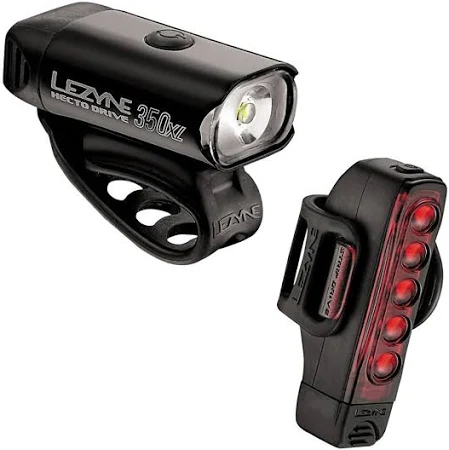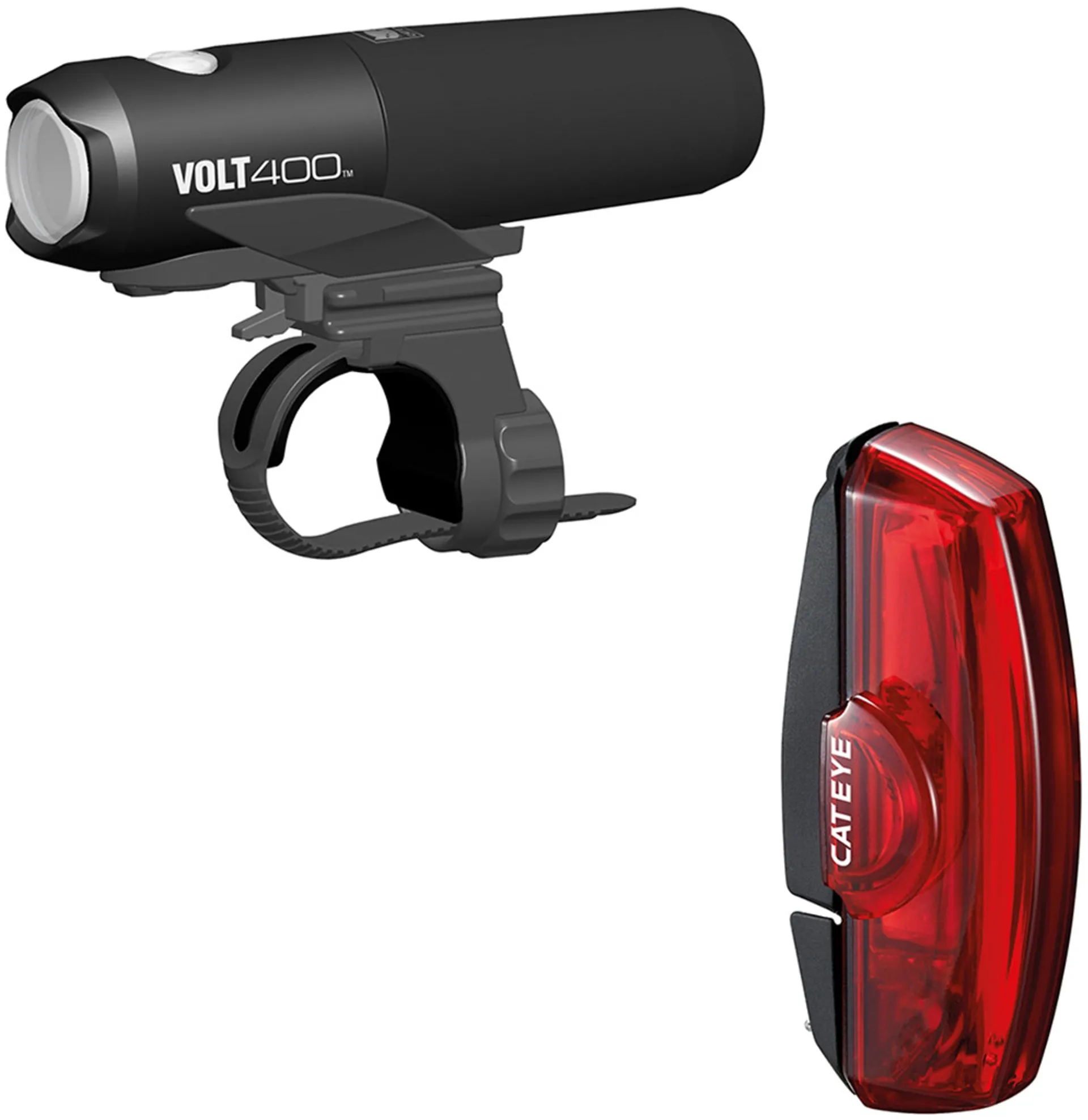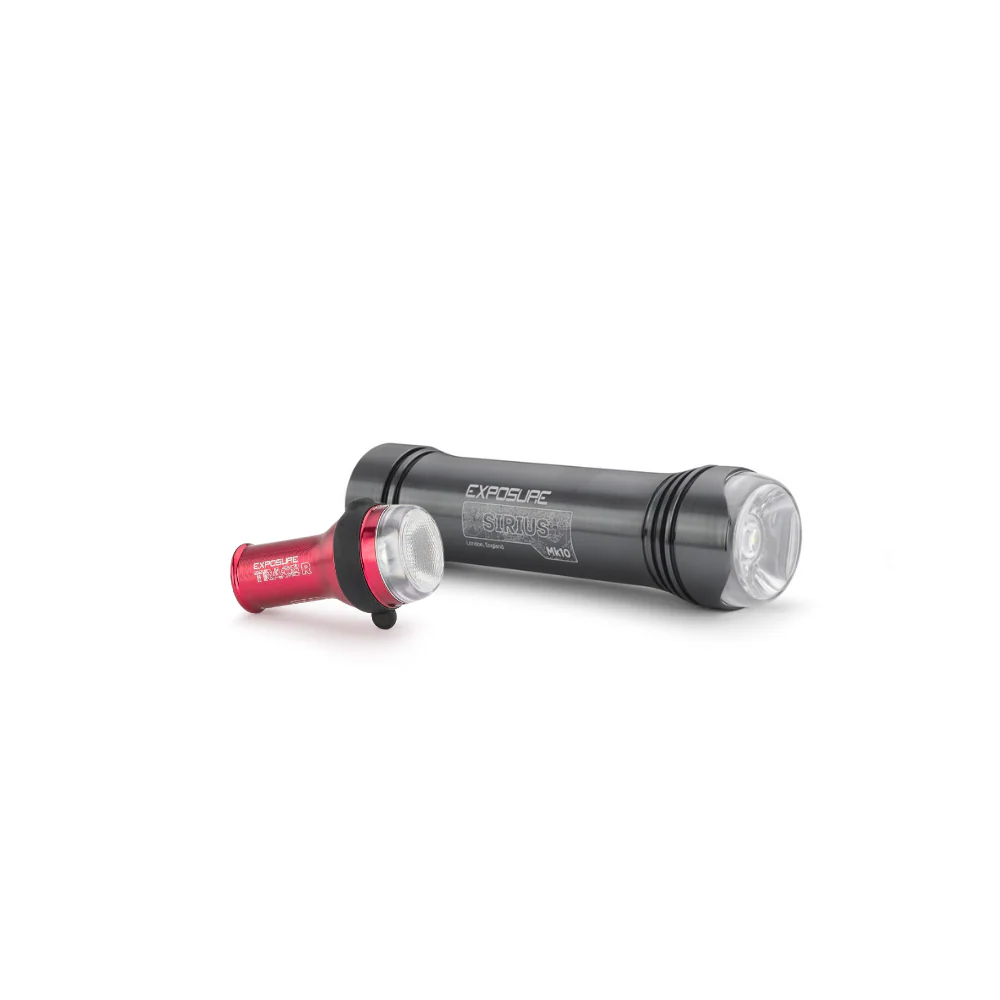BEST BIKE LIGHTS UK 2025

Cycling in the dark without proper lights isn’t just illegal in the UK – it’s genuinely dangerous. With winter nights stretching longer and darker commutes becoming the norm, a quality bike light isn’t optional. It could save your life.
The good news? You don’t need to spend a fortune on professional-grade equipment. We’ve inspected fitted and tested dozens of bike light sets under £50 to find which ones keep you visible, help you see the road ahead, and won’t die halfway through your commute.
Whether you’re cycling through London traffic, along unlit country lanes, or just popping to the shops after dark, this guide will help you choose the right lights.
🏆 Cateye Volt 400 XC / Rapid X2 Set – Powerful 400-lumen front light with smart rear brake light (£40-50)
💰 Best Budget: Lezyne Hecto Drive 350XL / KTV Pro Set – Excellent value with 350 lumens and aluminium construction (£25-35)
⭐ Best for Visibility: Exposure Sirius Mk10
/ TraceR Mk3 Set – Premium UK-made lights with intelligent daytime visibility (£45-50)
Table Of Contents
UK Cycling at Night: The Reality
- 77% of cyclist casualties occur in poor lighting conditions (reported cases)
- UK law requires white front and red rear lights between sunset and sunrise
- Rechargeable lights save you £50+ per year vs disposable batteries
- Peak cycling times: 6-9am and 5-8pm (mostly dark in winter)
- Highest risk areas: Urban junctions, unlit rural roads, shared paths
The bottom line: A £30-50 light set is cheaper than a single A&E visit or replacing a crashed bike.
Quick Specs:
- Price: £40-50
- Front Light Output: 400 lumens
- Rear Light Output: 50 lumens
- Battery Life: 3-30 hours (mode dependent)
- Charging: USB rechargeable (both lights)
- Weight: 120g (front), 22g (rear)
- Best For: Daily commuters, city and suburban cycling
Our Review:
The Cateye Volt 400 XC is the Goldilocks of commuter lights – not too bright to dazzle oncoming traffic, not too dim to leave you squinting. At 400 lumens, it provides excellent visibility on unlit roads while remaining street-legal for urban use.
The Rapid X2 rear light is where this set really shines. It features an accelerometer that automatically switches to high-power mode when you brake, just like a car’s brake lights. This is genuinely clever safety tech at an affordable price point.
Both lights feature tool-free mounting with Cateye’s FlexTight bracket system. Pop them on in seconds, no allen keys required. The front light has five modes ranging from full beam (3 hours runtime) to flashing (30 hours), while the rear offers constant and flashing options.
Battery indicators on both lights prevent that horrible “oh no, it’s going out” moment mid-ride. USB charging means you can charge them at your desk, and they fully charge in about 3 hours.
The build quality is excellent. Cateye is a Japanese brand with decades of experience, and it shows. These lights are IPX4 rated (splash-proof), which is fine for UK weather with mudguards. Without guards, you might want IPX7.
Yes, there are brighter lights available. But for most UK commuters cycling on a mix of lit and unlit roads, 400 lumens is the sweet spot between performance and battery life.

Our Rating: ⭐⭐⭐⭐⭐ 5/5
The best all-round commuter light set for UK cyclists. If you only buy one set, make it this one.
Quick Specs:
- Price: £25-35
- Front Light Output: 350 lumens
- Rear Light Output: 75 lumens
- Battery Life: 2-20 hours (mode dependent)
- Charging: USB rechargeable (integrated USB stick)
- Weight: 87g (front), 28g (rear)
- Best For: Budget-conscious cyclists, secondary light set
Our Review:
If £50 is genuinely too much, the Lezyne Hecto Drive 350XL set is the best compromise between price and performance. At around £25-35, it’s half the price of premium sets but still offers genuine quality.
The 350-lumen front light is CNC-machined from aluminium – you can feel the quality when you pick it up. This isn’t cheap plastic that’ll crack in winter. Seven different modes give you flexibility, from full blast (2 hours runtime) to economy flash (20 hours).
What we particularly like is the cable-free USB charging. The light has an integrated USB stick that flips out. Just plug it straight into your laptop. No cables to lose, no proprietary chargers to replace. It’s genuinely clever design.
The KTV Pro rear light punches above its weight at 75 lumens. Side visibility windows help drivers spot you at junctions. Four modes include a pulse setting that’s proven more effective than standard flashing for grabbing attention.
The rubber strap mounting system is basic but works. It’s not as quick-release as Cateye’s system, but it’s secure and fits most handlebars and seatposts.
Battery life is good for the price point. The front light will handle a week of typical commuting (30 mins each way) without charging. The rear will last two weeks.
Build quality is excellent for this price bracket. Lezyne is a well-respected brand in cycling, and these lights don’t feel like a budget option. They’re IPX7 rated (fully waterproof), which is better than lights costing twice as much.
Reality check: These lights are fine for suburban commuting and well-lit city roads. For pitch-black rural lanes or high-speed riding, you’ll want more lumens. But for most UK cyclists, they’re perfectly adequate.

Quick Specs:
- Price: £45-50
- Front Light Output: 900 lumens
- Rear Light Output: 75 lumens with ReAKT technology
- Battery Life: 1.5-36 hours (mode dependent)
- Charging: USB rechargeable
- Weight: 130g (front), 35g (rear)
- Best For: Year-round commuters, rural roads, daytime visibility
Our Review:
Exposure lights are handmade in the UK, and you can feel the difference. The Sirius Mk10 is at the top of our price bracket but justifies every penny with features and build quality you won’t find elsewhere under £50.
The 900-lumen output seems overkill until you ride unlit country lanes at speed. Then you realize why serious cyclists swear by this light. The beam pattern is excellently designed – focused ahead to show potholes and road surface, with enough spread to catch reflective signs and hazards at the roadside.
Multiple modes include a clever day flash that makes you visible in broad daylight. This is genuinely effective – drivers see you much earlier. If you ride dawn or dusk commutes, it’s worth it for this feature alone.
The TraceR rear light uses Exposure’s ReAKT technology. An ambient light sensor automatically adjusts brightness. In daylight or well-lit streets, it pulses at maximum brightness. In darkness, it dims to avoid dazzling riders behind you while maintaining visibility.
Build quality is exceptional. CNC-machined aluminium bodies, proper O-ring seals, and IPX7 waterproofing. These lights laugh at British weather. Drop them, get them muddy, ride through floods – they keep working.
The “fuel gauge” LED indicator shows remaining battery life accurately. No guessing, no sudden failures. When it shows red, you genuinely have the time it says before they die.
Cable management is thoughtful. The USB charging port has a proper sealing cover that actually stays on (unlike cheaper lights where it falls off after a week).
Weight is slightly higher than competitors, but that’s because these lights are built like tanks. If you’re not a weight weenie, it’s a non-issue.
Trade-off: At £45-50, you’re at the top of the “budget” category. But these lights will last 5+ years with proper care, where cheaper lights die after 2-3 winters. Cost per year makes them excellent value.

FAQ SECTION – Best Bike Lights UK 2025
Yes. UK law requires a white front light and red rear light between sunset and sunrise. Specifically, you need BS6102/3 or equivalent approved lights. Fines for cycling without lights can be up to £1,000, though typically it’s £50 on-the-spot. More importantly, you’re invisible to drivers without lights. Not worth the risk.
For well-lit city streets: 100-200 lumens is adequate for visibility. For mixed lit/unlit roads: 300-500 lumens recommended. For unlit country lanes: 600-1000+ lumens if riding at speed. Remember: lumens aren’t everything. Beam pattern and quality matter more than raw numbers.
Rechargeable wins for commuters. You’ll save £50+ per year on batteries, and modern USB lights offer better performance. Battery-powered lights are only worth it for occasional riders or as emergency backups. The convenience of charging at your desk can’t be beaten.
UK law allows both, but research suggests a combination is most effective: rear light on flash or pulse mode (more attention-grabbing), front light on steady (better for judging distance and speed). Never use flashing-only front lights on unlit roads – you need steady beam to see obstacles.
Quality lights (like our recommendations) should last 3-5 years with proper care. Rechargeable batteries typically handle 500+ charge cycles before degrading. Signs you need replacement: won’t hold charge, cracked housing, water ingress, or beam brightness significantly reduced. Budget lights often die after 1-2 years.
Not recommended in theft-prone areas. Quick-release mounts exist for a reason – pop them off when locking up. Even cheap lights are stolen from bikes. If you have secure storage or live in a low-crime area, it’s fine. Always remove them when locking in public.
IPX4: Splash-proof. Fine for light rain, not for heavy downpours or pressure washing. IPX7: Waterproof. Immersion in water up to 1 meter for 30 minutes. For UK weather, IPX4 is minimum, IPX7 is better. If you don’t use mudguards, get IPX7 – road spray is surprisingly harsh on lights.
Yes. Road/commuter lights (our recommendations) focus on being seen and seeing road surfaces. Mountain bike lights need wider beams (to see trail edges), helmet mounts (light follows where you look), and much higher lumens (800-2000+). Our guide focuses on commuter/road lights only.
Sets offer better value and matched performance. Buying separately lets you customize (e.g., premium front, budget rear), but you’ll pay more overall. For most riders, matched sets are the smart choice. Only buy separately if you have specific needs or already own one light.
Use quick-release mounts and remove lights when locking up. If you forget, thieves will take them. Some riders use old, taped-up lights for pub/shop stops, keeping good lights for actual riding. Security marking (UV pen) can help police return stolen lights, but prevention is better.
Some are fine, many are garbage. Claimed lumens are often fake (500 lumens marketed, 200 actual). Build quality is lottery. Stick to known brands (Cateye, Lezyne, Exposure, Knog) bought from reputable retailers. If it’s £10 for “3000 lumens,” it’s lying. Our recommendations are trustworthy brands only.
Front: Centre of handlebars, parallel to ground, high enough not to hit knee. Rear: Seatpost (most common), or seat stay for full-suspension bikes. Position so it’s not blocked by bags or clothing. Some riders use two rear lights (seatpost + helmet/bag) for extra visibility.
Not legally required, but highly recommended. Studies show daytime flashing lights reduce accidents by up to 19%. The Exposure set’s day flash mode is excellent for this. If you commute on fast, busy roads, daytime lights are worth running. Battery drain is minimal on flash mode.
HOW TO CHOOSE THE RIGHT BIKE LIGHTS
1. Match Lights to Your Riding Environment
Urban/City Commuting (Well-Lit Streets):
- Front: 100-300 lumens sufficient
- Rear: 50-100 lumens adequate
- Focus on side visibility and being seen
- Battery life matters more than brightness
Suburban/Mixed Lighting:
- Front: 300-500 lumens recommended
- Rear: 75-150 lumens with pulse mode
- Balance between visibility and seeing ahead
- This is where most UK commuters ride
Rural/Unlit Roads:
- Front: 600-1000+ lumens essential
- Rear: 100+ lumens, highly visible
- Wide beam pattern critical
- Premium lights justify their cost here
Pro Tip: Measure your actual route. If 80% is lit streets with 20% dark path, buy for the dark 20%. You need lights for the worst section, not average.
2. Understand Lumens vs Beam Pattern
The Lumen Myth: More lumens doesn’t automatically mean better. A 300-lumen light with excellent beam pattern can outperform a 600-lumen light with poor focus.
What Matters:
- Beam width (too narrow = tunnel vision, too wide = poor distance)
- Hot spot intensity (for seeing potholes)
- Even distribution (no dark patches)
- Anti-dazzle design (for oncoming traffic)
UK Standard: Look for STVZO approval (German standard accepted in UK). These lights have certified beam patterns that don’t dazzle.
3. Battery Life: Runtime vs Mode
Real-World Math: If your commute is 30 minutes each way:
- Budget 5 hours weekly (1 hour/day working days)
- Add 20% buffer for forgetting to charge
- You need ~6 hours minimum runtime
Modes Matter: Don’t just check maximum brightness runtime. Check the mode you’ll actually use:
- Eco/Low mode: Best runtime, adequate for lit roads
- Mid mode: Sweet spot for most riding (what we test)
- High mode: Shortest runtime, needed for dark lanes
- Flash mode: Longest runtime, but can’t see obstacles well
Charging Frequency: Daily charging: Annoying but acceptable Weekly charging: Ideal for most commuters Monthly charging: Rare, only basic lights
4. Mounting Systems Compared
Quick-Release Strap (Rubber): ✓ Fast on/off (essential for security) ✓ Fits multiple bikes easily ✓ No tools required ✗ Can slip on smooth surfaces ✗ Rubber degrades over time
Clamp Mount (Screw): ✓ Very secure ✓ Precise positioning ✗ Slow to remove (theft risk) ✗ Tool required
GoPro Mount: ✓ Universal standard ✓ Under-bar mounting possible ✗ More expensive ✗ Extra adapter needed
Our Recommendation: Quick-release for commuters (remove when locking up). Clamp mount only if you have secure storage.
5. Weatherproofing Explained
IP Ratings Decoded:
- IPX0: No protection (don’t buy)
- IPX4: Splash-resistant (light rain okay)
- IPX5: Water jets (heavy rain okay)
- IPX7: Waterproof (submersion okay)
UK Requirements: Minimum IPX4 if you have full mudguards IPX7 recommended without mudguards (road spray is harsh)
Winter Durability: Check temperature tolerance. Cheap lights die in freezing weather. Quality lights work -20°C to +50°C.
6. Rechargeable vs Disposable
USB Rechargeable: ✓ Save £50+ per year on batteries ✓ Better performance per pound ✓ Environmental benefit ✗ Must remember to charge ✗ Battery degrades after 500 cycles
Disposable Battery: ✓ Instant replacement (shops/petrol stations) ✓ Good for occasional riders ✗ Expensive long-term ✗ Weaker performance ✗ Environmental waste
The Math: Daily commuter: Rechargeable saves £50-80/year Weekend rider: Disposable acceptable Our recommendation: Rechargeable primary lights, disposable emergency backup
7. Additional Features Worth Considering
Auto On/Off: Light sensor turns lights on at dusk. Convenient but drains battery. Not essential.
Brake Light Function: Accelerometer detects braking (like Cateye Rapid X2). Genuinely useful safety feature.
Battery Indicator: Essential. Prevents being caught out with dead lights. LED or percentage display.
Smart Connectivity: Bluetooth app control, ANT+ integration. Nice to have but not worth paying extra unless you’re a data geek.
Memory Function: Remembers last mode used. Saves clicking through modes every ride. Surprisingly useful.
Side Visibility: Windows or side LEDs. Very important for UK junctions where drivers pull out from side roads.
8. Budget Reality Check
Under £20: Basic protection only. Fine for well-lit city cycling or emergency backup. Don’t trust your safety to these long-term.
£20-35: Entry-level quality (like Lezyne set). Good for most commuters on mixed roads. Sweet spot for value.
£35-50: Premium commuter lights (like Cateye/Exposure). Better build, features, longevity. Worth it for daily riders.
£50-100: Professional grade. Overkill unless you ride fast on unlit rural roads or need 1000+ lumens.
Our Honest Advice: Don’t cheap out on lights. A £30-50 set protecting a £500 bike (and your life) isn’t an expense – it’s insurance. The difference between £25 and £45 is build quality that lasts 3x longer.
FINAL VERDICT: WHICH LIGHTS SHOULD YOU BUY?
Choosing the right bike lights comes down to where you ride, how often, and your budget.
For Most UK Commuters: The Cateye Volt 400 XC / Rapid X2 Set (£40-50) is the best investment. The 400-lumen output handles everything from city streets to country lanes, and the automatic brake light rear is genuinely clever safety tech. If you cycle regularly and can afford it, this is the set to buy.
On a Tight Budget: The Lezyne Hecto Drive 350XL / KTV Pro Set (£25-35) delivers real quality at half the price. The aluminium construction and cable-free charging make it feel premium. Perfect for city commuters or as a second set for your backup bike.
Year-Round Serious Riders: The Exposure Sirius Mk10 / TraceR Mk3 Set (£45-50) is UK-made excellence. The 900-lumen front handles pitch-black rural lanes, while the intelligent ReAKT rear adjusts to ambient light automatically. These lights will outlast cheaper sets by years.
Don’t Wait Until It’s Too Late. With darker evenings already here, every ride without proper lights is a risk. Bike light-related accidents spike in autumn when cyclists haven’t switched from summer visibility habits.
Remember the True Cost: A £40 light set seems expensive until you compare it to:
- £1,000 fine for riding without lights
- £300+ for hospital treatment after a night accident
- £500-2000 replacing your bike after a crash
- Your life (priceless)
One Final Tip: Whichever lights you choose, use them correctly every single time. Lights on from dusk (even if it’s not fully dark yet), positioned properly, charged regularly. Even the best £50 lights are useless if they’re sitting flat at home.
Need More Help? Check out our guide to bike locks for keeping your bike secure, or get in touch if you have questions about cycling safety in Bournemouth and Dorset.


